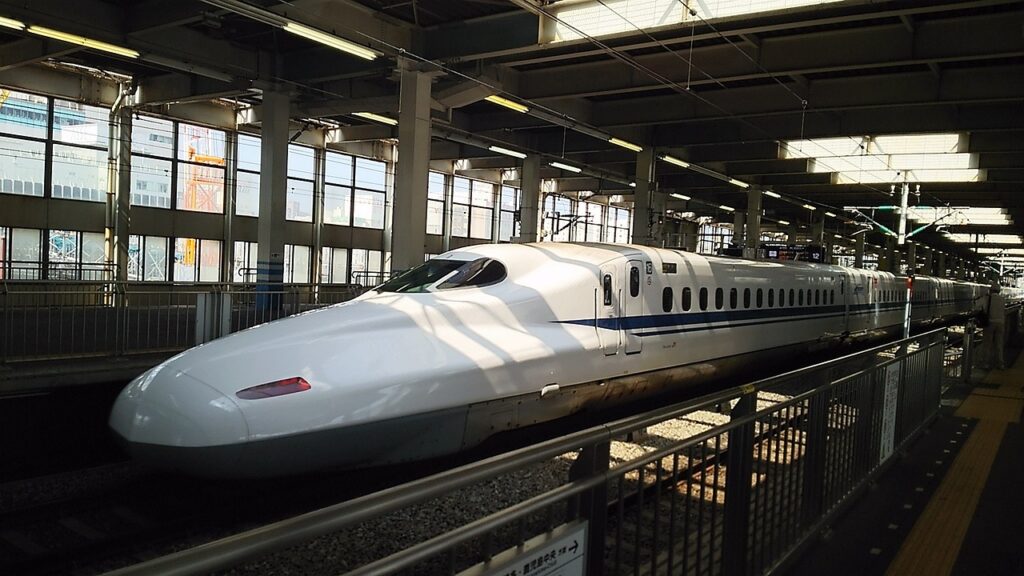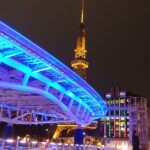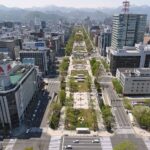Hiroshima’s public transportation system is extensive, including buses, trams, and the monorail system known as the Hiroshima Rapid Transit (HRT). The bus network serves the rest of the city, while the tram system serves the downtown and surrounding districts. With 22 stops across the city, the HRT monorail is a convenient way to get around. The Hiroshima Transportation Bureau, which is in charge of running the city’s public transportation, sells passes at its ticket vending machines. The public transportation system makes it simple to get to all of the major tourist hotspots.
Metro system in Hiroshima: basic information
Hiroshima, Japan, is home to a modern metro system known as the Hiroshima Metro. Opening in ’94. The overall train length of the Hiroshima Metro is 18.4 kilometers, serving 22 stops (including the Hiroshima Airport station). It links the city’s primary business districts, residential neighborhoods, and tourism destinations. On average, over 350,000 people ride the subway every day. The Hiroshima Metro is a vital aspect of Hiroshima’s public transportation system, providing residents and visitors with an easy and inexpensive method to get around the city.
The astram line (line 1)
The Astram Line, or Hiroshima New Transit Line 1, is a public transportation route in Hiroshima, Japan that runs on rubber tires and is managed by Hiroshima Rapid Transit. On August 20, 1994, in time for the Hiroshima Asian Games, Astram first opened its doors. The railway links the heart of Hiroshima to the Asian Games’ primary venue, Hiroshima Big Arch. The Astram Line and the JR lines are now directly connected thanks to the opening of the Shin-Hakushima station on March 14, 2015.
Map of Hiroshima Metro 2024: Free Download

Click and download the map of Hiroshima’s underground system for 2024
You can get a free PDF copy of the Hiroshima subway map for the year 2024 right now. This map will help you get around Hiroshima, Hiroshima Prefecture, and the neighboring areas with ease. Bus lines that connect to and from the Hiroshima City Subway and Hiroshima Prefecture Rail lines are also included on the map. The map not only shows the locations of restaurants, shopping malls, and museums but also provides extensive information on the city’s other attractions and services. With this map in hand, you’ll have no trouble finding your way around Hiroshima’s historic neighborhoods and modern attractions.
Public transport tickets in Hiroshima: best types for travelers
Coming to Hiroshima? Whether you’re a native or a visitor, you’ll need to be familiar with the various public transportation passes offered in the city. Depending on your preferences and budget, you can choose from several different types of tickets.
The Hiroshima Sightseeing Pass is an excellent choice for individuals who need to swiftly navigate the city. You can use it on the city’s streetcars and buses for two full days. The Hiroshima Peace Memorial Museum, for example, is just one of many places where you can save money by purchasing this pass. Adults can get this pass for 1800 yen, while kids pay only 900 yen.
The Hiroshima City Sightseeing Pass is ideal for people who like to leisurely discover the city’s many attractions. This card gives you access to all streetcar and bus lines in the city for three consecutive days. The Hiroshima Peace Memorial Museum, for example, is only one of many sights that are on sale. This pass will set you back 2600 yen (about $26) for adults and 1300 yen (about $13) for kids.
The Hiroshima Bus Pass is ideal for people who prefer to see the city at their own leisure. This ticket is good for one day of unlimited bus travel around the city. The adult price of this pass is 500 yen, while the kid price is 250 yen.
The Hiroshima Streetcar Pass is a convenient way to see the city by streetcar. For one day, you have access to the city’s streetcar system with this card. This pass will set you back 600 yen for an adult and 300 yen for a youngster.
The Hiroshima All Area Pass is the most practical method to see the city’s top attractions. This card is good for three days of unlimited rides on the city’s streetcars and buses. The adult price for this pass is 3500 yen, while the child price is 1750 yen.
The greatest value for travelers with three days in Hiroshima is the Hiroshima All Area Pass. This pass is the easiest method to see everything the city has to offer and save money at the same time.
Timetables & Schedules of the Hiroshima subway
On weekdays, the Hiroshima Metro is open from 5:30 a.m. to midnight, on weekends from 7:00 a.m. to midnight, and on holidays and Sundays from 8:00 a.m. to midnight. At various times of the day and along various routes, trains arrive every three to seven minutes. At peak times, trains depart at least every three minutes.
Public Transportation – other form of transport
The metro isn’t the only kind of public transit available in Hiroshima. Among these are the Hiroshima Sightseeing Bus, the Hiroshima Electric Railway, the Hiroshima Bus Company, and the JR West Line. Between Hiroshima Station and Iwakuni Station, you can catch the JR West Line; meanwhile, the Hiroshima Bus Company operates several services within and beyond the city. The Hiroshima Sightseeing Bus and the Hiroshima Electric Railway are both excellent ways to visit the city’s sights along the city’s Western coast. Getting around Hiroshima is a breeze because of the city’s numerous and convenient public transportation choices.
how does public bus transportation work in Hiroshima?
Hiroshima, a bustling metropolis in Japan’s Chugoku region, is easily navigable by the city’s inexpensive and efficient bus system. The Hiroshima City Bus System provides a convenient way for tourists and locals alike to travel throughout the city and see its many attractions.
Five major bus lines make up the Hiroshima City Bus System: the Sakaibashi Line, the Kamiyacho Line, the Hiroshima Bus Pass, and the Hiroshima City Loop Bus. All of Hiroshima’s major landmarks and residential areas are accessible via any of the five lines.
Hiroshima Station, Hiroshima Castle, Hiroshima Peace Park, and the Hiroshima Atomic Bomb Dome are all accessible through the city’s most frequently used bus route, the Hiroshima City Bus. The Hiroshima City Loop Bus provides yet another useful loop service throughout the city. Passengers can ride the Hiroshima City Bus and the Hiroshima City Loop Bus as often as they like with a single Hiroshima Bus Pass.
The Sakaibashi Line connects Hiroshima Station and Sakaibashi Station, making it convenient for tourists to travel between these two popular destinations in the heart of the city. The Kamiyacho Line, which runs from Hiroshima Station to Kamiyacho Station, is convenient for getting about Hiroshima’s commercial and nightlife hubs.
Buses in Hiroshima are all clearly marked with the line name or the bus number, and their bright colors make them easy to spot. In Hiroshima, you can pay for rides on the bus with cash or a prepaid IC card.
In conclusion, riding the city buses in Hiroshima is a fast, cheap, and convenient method to move around town. The city’s five lines make it easy for tourists and locals alike to see all the sights. The Hiroshima City Bus System will get you where you want to go, whether that’s the downtown area or the suburbs.
How do the public trains work in Hiroshima?
Hiroshima is a key transportation center in Japan, and the train is a crucial part of that. Hiroshima’s public train system provides residents and visitors with a dependable and time-saving means of getting through the city and its environs.
The Hiroshima Electric Railway (HER) is the primary rail carrier in the area, connecting several of the prefecture’s major cities and towns. The Hiroshima Rapid Transit Line, which runs from Hiroshima City to Hiroshima Airport, is one of the many lines operated by the HER. Others include the JR Sanyo Main Line, the JR Geibi Line, the Osaka Loop Line, and the HER’s own Hiroshima Loop Line.
One of the most significant lines in the Hiroshima region, the JR Sanyo Main Line links Hiroshima City to other major cities like Osaka, Okayama, and Fukuyama. Also significant is the Osaka Loop Line, which links the two major cities of Osaka and Hiroshima.
The JR Geibi Line is a major connection between Hiroshima and the surrounding area, including smaller cities like Takehara, Mihara, Kure, and Fukuyama. Visitors looking to see the rural parts of Hiroshima Prefecture will find this line particularly helpful.
If you want to see more of Hiroshima City and its surroundings, the Hiroshima Rapid Transit Line is just as useful as the JR lines. With this line, passengers can travel from Hiroshima Station to Hiroshima Airport with ease.
How To Get From Hiroshima-Nishi Airport (HIW) To The City Center With Public Transport?
Taking public transportation from Hiroshima-Nishi Airport to the heart of the city is a simple and quick option. Hiroshima-Nishi Airport is accessible by bus, train, and tram from the city center, which is located 9 kilometers east of the airport.
Taking a bus from Hiroshima-Nishi Airport into the heart of the city is the most time-efficient option. The Airport Limousine Bus, the Hiroshima City Bus, and the Hiroshima Sightseeing Bus all stop at the airport. The airport and Hiroshima Station, in the heart of the city, are both served by these buses. Getting to Hiroshima Station from the airport is the quickest alternative, taking only about 20 minutes on the airport limousine bus. Adult tickets cost 700 yen, while kid tickets cost 350 yen. The Hiroshima City Bus, which takes around 40 minutes to reach Hiroshima Station, is the most cost-effective choice. Adults pay only 200 yen, while kids pay just 100 yen. The Hiroshima Sightseeing Bus is the least efficient way to get to Hiroshima Station, taking around 45 minutes. Adults pay 500 yen and kids pay 250 yen.
Hiroshima-Nishi Station is connected to Hiroshima Station via the JR Sanyo Line. Adult tickets for the train cost 210 yen, while kid tickets cost only 110 yen. The ride takes about 15 minutes.
Once at Hiroshima-Nishi Station, take the Kishorin tram to Hiroshima Station. Tram rides cost 210 yen for adults and 110 yen for kids and take around 30 minutes to complete.
In conclusion, using public transportation to get from Hiroshima-Nishi Airport to the heart of the city is quick and easy. The Kishorin tram, the JR Sanyo Line railway, and three different bus lines are all accessible from this area. These routes all terminate at Hiroshima Station, which is conveniently positioned in the heart of the city.
How do I spend 3 days in Hiroshima?
It is recommended that first-time visitors to Hiroshima spend at least three days exploring this fascinating city. Here’s a strategy to make the most of your time in Hiroshima over three days, from must-see attractions to local favorites in dining and nightlife.
Day 1: The rich history of the city
Take in some of Hiroshima’s rich history first thing in the morning. Visit the Hiroshima Peace Memorial Park to see the city’s past and present in one place, including displays of the atomic bomb’s effects on the city’s architecture. The neighboring Hiroshima Castle dates back to the 16th century and is well worth a look.
Take the ferry in the afternoon to Miyajima, an island noted for its torii gate and scenic views. Take your time touring the island’s various temples and shrines, and don’t leave without sampling the famous oysters and other local fare.
Stop by the Hiroshima Night Food Market on your way home to try some international cuisine.
Day 2: Start with a shopping spree
Get out and about in the city’s bustling shopping districts in the morning. Start your shopping adventure at the Hondori Arcade, where you can purchase anything from trinkets to designer clothing. Visit the neighboring Shukkei-en Garden to look at some old artifacts.
Visit the Hiroshima Museum of Art for a restful afternoon. The museum’s garden is a tranquil place to relax after exploring the museum’s extensive collection of Japanese and international artwork.
The trendy Motomachi District is home to several excellent dining options. Spend your evening exploring Hiroshima’s exciting club scene.
Day 3: Botanical Garden
The Hiroshima Botanical Garden is a great place to start your day. Featuring a wide range of flora, this park is an ideal spot to unwind and appreciate nature.
The Hiroshima Prefectural Art Museum is worth a look afterward for its collection of both Japanese and foreign works of art.
Evenings are perfect for a stroll along the waterfront of Hiroshima. There are plenty of places to eat, drink, and people-watch as the sun goes down along this stretch of the coast.
Visit one of Hiroshima’s many Izakayas for a drink and some tasty nibbles to round out your three days here.
Your three days in Hiroshima will be well spent if you follow this itinerary. Hiroshima has much to offer everyone, from its rich history to its exciting nightlife.
What other metro systems are near Hiroshima?
The Tokyo Metro is the biggest subway system in Japan, not only in terms of its physical scale but also in terms of passenger volume. It consists of nine lines, covering 195.1 kilometers and serving approximately 6.84 million passengers daily. Following Tokyo Metro, the Osaka Metro is the second largest, encompassing 8 lines and 133 kilometers and serving about 2.3 million passengers daily. Other significant subway systems include the Yokohama Municipal Subway, the Fukuoka City Subway, and the Nagoya Municipal Subway, each of which serves millions of passengers and covers extensive areas within their respective cities.
A Video Guide to Public Transportation in Hiroshima.
Summary of our tour guide for Hiroshima
I was born and raised in the great city of Hiroshima. Over the years, I’ve come to have great respect for the city’s public transit network. Although Hiroshima is a huge city, getting around and seeing all there is to see is a breeze thanks to the excellent public transit system. You can travel from one end of the city to the other in a reasonable amount of time thanks to the dependable and efficient public transportation system. The pricing structure is fair, and the employees are helpful and friendly at all times. The public transit system in Hiroshima is highly recommended for moving around the city.
Top 5 FAQs and answers about Hiroshima public transport?
- What are the different options for public transportation in Hiroshima?
- The Hiroshima Rapid Transit system, as well as buses, trams, and ferries, make up the city’s public transportation network. Since buses serve much of the city, they are the most popular mode of transportation. The trams are convenient for traveling around the downtown area, while the ferries allow you to reach the surrounding islands. The Rapid Transit system connects the surrounding neighborhoods to Hiroshima’s central business district.
- What is the cost of using Hiroshima’s public transportation system?
- Hiroshima’s public transportation prices vary by mode and distance traveled. Single rides on buses and trams typically cost around 200 yen. Fares on ferries and the Hiroshima Rapid Transit system begin at roughly 500 yen.
- Is it possible to purchase a single ticket for use on all Hiroshima public transportation?
- Yes, all Hiroshima public transportation uses the same ticket. The “Hiroshima Smart Card” is accepted on all Hiroshima Rapid Transit buses, trams, ferries, and subway lines. You can buy the card at 7-Elevens and ticket vending machines.
- Where can I find information on Hiroshima’s public transportation discounts?
- Hiroshima’s public transportation does offer discounts, though. Students typically receive the largest discounts (up to 50% off). Senior citizens and those with disabilities can also receive discounts.
- Does Hiroshima’s public transportation system offer any specialized assistance?
- Public transportation in Hiroshima does offer accessible options. The “Sky Express” service is the most well-known, and it operates as a rapid-transit bus line between Hiroshima Station and the airport. Additionally, tourists can make use of dedicated services like the “Hiroshima Sightseeing Bus” and the “Hiroshima City Tourist Loop Bus.”
Useful links







